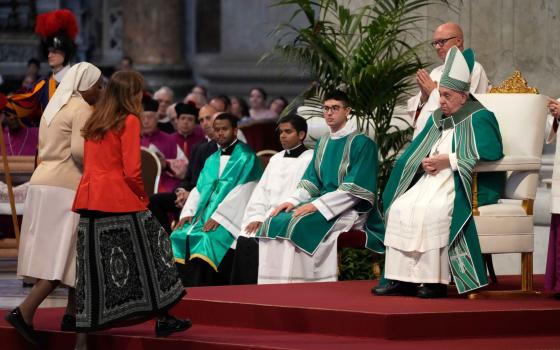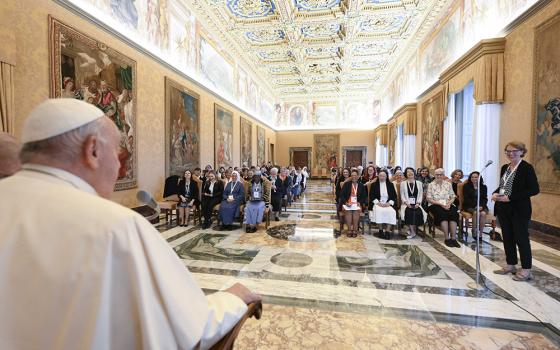
(NCR illustration/Toni-Ann Ortiz; photo by Dreamstime/Melinda Nagy)
More than 100 years ago, after decades of lobbying, protest and activism by suffragists, women in the United States won the right to vote with the passage of the 19th amendment to the Constitution. Now — finally! — some women will have voting power at one of the most important assemblies in the Catholic Church.
The upcoming Synod of Bishops, to be held in October 2023 and 2024 at the Vatican, will expand its voting members to include 70 nonbishop members, half of whom will be women, Pope Francis announced April 26.
Theologians and activists have praised this latest move as "significant" and a "substantial development." Others called it a "crack in the stained glass ceiling."
We couldn't agree more. Although the church still has a long way to go to address clericalism and discrimination against women within its own institutions, this step gives us hope that the church is moving in the right direction.
This decision to add laypeople (including religious sisters and brothers) as voting members at the synod did not come out of the blue. Inspired by the Latin American bishops' conference CELAM, Francis has throughout the past decade made moves to reform the synod process, transforming it from the "rubber stamp" affairs of previous pontificates to actual conversations that have included input from people in the pews.
Input, but not votes.
Although women religious have been "observers" at previous synods, they have not had voting privileges. Encouraged by the addition of a religious brother to the synod on the family in 2015 and two nonordained male religious superiors to the synod on young people, the faith and vocational discernment, several reform groups launched a "Votes for Catholic Women" campaign that pointed out the clear sexism of the ban on voting rights for women religious but not men religious. Again, Francis may have been inspired by CELAM, which included nonbishops as voting members at its last assembly.
Advertisement
The preparatory document for the 2021-24 synod on synodality acknowledges the challenge: "The whole Church is called to confront the weight of a culture impregnated with clericalism, inherited from its history, and forms of exercising authority in which various types of abuse (of power, economic, conscience, sexual) are inserted," it said. "A conversion of ecclesial action is unthinkable without the active participation of all the members of the People of God."
It's worth noting that issues raised at recent synods, with input from nonvoting observers — Communion for divorced and remarried Catholics at the synods on the family; LGBTQ issues at the synod on young people; ordination for married men at the synod on the Amazon — have resulted in relatively minimal or in some cases no change to church practice or teaching.
Whether change will be more forthcoming when upward of one fourth of the synod voting members are lay remains to be seen. And much will depend on the specific laypeople chosen to serve in these positions. (As if to remind us that not all church leaders believe in women's equality, a U.S. bishops' conference committee chairman released a statement praising Senate blockage of the Equal Rights Amendment two days after the announcement expanding lay synod voting.)
But for now, it is time to celebrate and to express gratitude for those who have long advocated for this — including some who, like their fellow suffragists, risked arrest. However the church got to this point, this is an important and historic step.
It seems only fitting that a process dedicated to listening seems to have accomplished just that: listening and responding to voices raised through the synod process itself repeatedly calling for expanded roles and leadership for women. With this move, the synod has truly "enlarged the space of our tent" by including a more representative group of the people of God "walking together."







